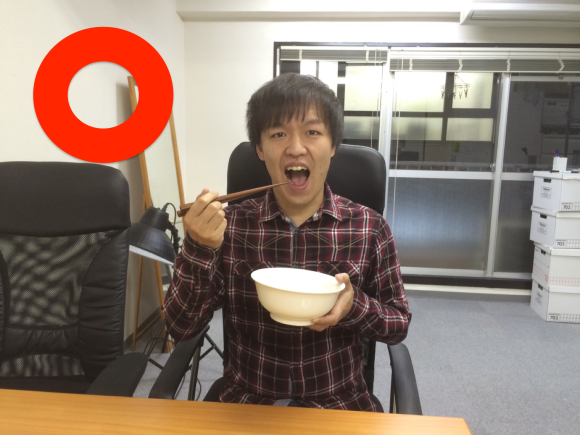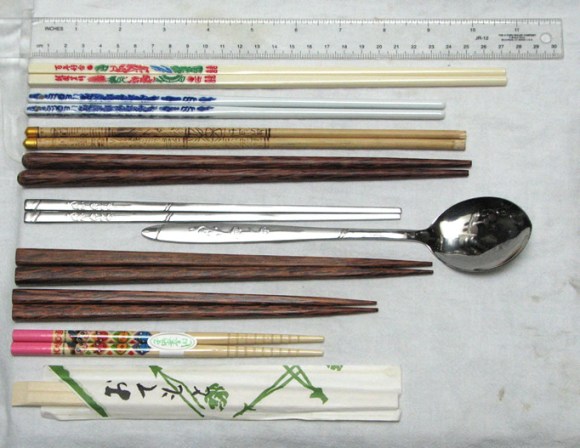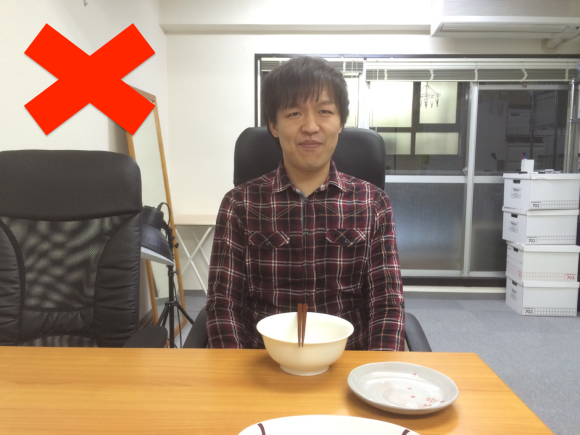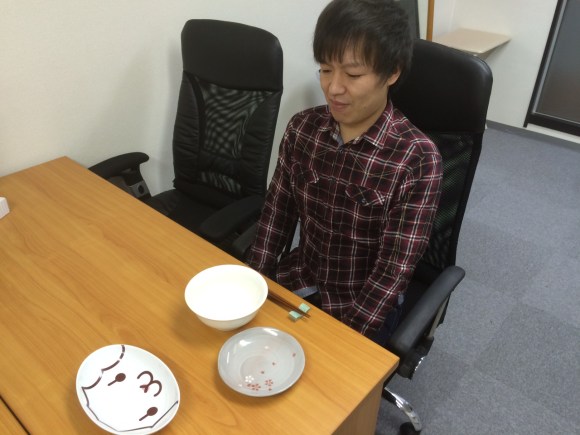
We’ve been seeing a lot of articles recently about how to use Japanese chopsticks correctly. For those of us who grew up using forks and knives, it may seem a bit silly to obsess over holding two sticks at the correct angles. If you plan on visiting, living in, or especially working in Japan at some point, though, it may be a good idea to get out a protractor and practice those angles to save yourself a lot of embarrassing moments with friends and coworkers later.
To help you out, we here at RocketNews24 have compiled seven facts about chopsticks to help you along in your quest for perfect Japanese table manners. Even if you’re a seasoned chopstick expert, you may learn a thing or two from our advanced-level tips.
#1: In Japan, everybody has their own personal chopsticks
It may sound strange to anyone who grew up in a household where you just used whatever silverware (or plasticware!) was placed in front of you, but in Japan it’s quite common for each member of the family to have his or her own personal pair of chopsticks. Dad has his big, manly ones; mom has her long, thin ones; the kids have Pokémon ones, and they’re all typically washed and reused every day. Use someone else’s chopsticks at your own risk.
▼ Pick the wrong ones and you’ll be using the spoon for a week.
#2: Most Japanese chopsticks are made of wood
As opposed to countries like Korea where metal chopsticks are extremely common, most Japanese chopsticks are made of wood. Wooden chopsticks are preferred since they don’t conduct heat (useful when you’re eating very hot food), provide a more stable grip, and are cheaper to produce. There are chopsticks made out of a variety of other materials, such as luxury chopsticks made of gold or silver, but the second-most common material is plastic, typically used for children’s chopsticks.
▼ Or for Pocky-shaped chopsticks to eat Pocky with.

#3: If the food is hard to pick up with chopsticks, bringing the bowl/plate up to your mouth is acceptable
The first time anyone is given a bowl of miso soup and a pair of chopsticks with no spoon in sight, panic usually takes over, but stay calm! You’re not expected to defy any laws of physics by picking up the soup with chopsticks; simply bring the bowl up to your mouth and drink. That may get you kicked out of some fancy restaurants outside of Japan, but here it’s expected. Feel free to do the same with bowls of rice, or anything else that doesn’t seem like it’d survive the whole trip up from the table to your mouth.
#4: Resting your chopsticks across your plate/bowl is a heinous crime
Resting your chopsticks across your plate/bowl is a big no-no in Japan. To Japanese people, it looks like a bridge over a river, specifically the Sanzu River, the Japanese river of the dead.
▼ You could say the Western equivalent is the River Styx… or River Chopstyx!
When you want to take a break from eating (or you’re being forced to take a break from eating), be sure to place your chopsticks on a rest with the pointed ends going up. If you don’t have a chopstick rest, there’s plenty of ridiculous ones to choose from, or you can make your own origami ones too.
▼ It’s also considered good form to place the chopsticks as close to you as possible, so no one else has to see your dirty utensils.
#5: There is an extra-fancy “two hand chopstick raise” that can be used to impress
Most people just grab their chopsticks with one hand and get right down to business eating, but if you really want to show off your skills, then give this little beauty a try:
You basically use your right hand to put the tips of your chopsticks into your left hand, rotate your right hand, then slowly raise both hands off the table. Doing so shows extra appreciation for the meal, and will have everyone nodding their heads approvingly at you while tears of joy stream down their cheeks.
#6: Wari-bashi (disposable chopsticks) are everywhere
When you’re out eating, the personal chopsticks go out the window and you just have to use whatever is available. Wari-bashi are extremely common in Japan, and you use them in restaurants, at picnics, at convenience stores, when you visit other people’s houses… basically anywhere imaginable. They’re notoriously difficult to break apart if you’re not used to it, so don’t feel ashamed if you have to buy a couple pairs to practice with in the privacy of your own home.
▼ Then when it comes time to break your own pair apart in public, channel your inner Osaka and give it your best shot.
#7: Using your own chopsticks on a communal plate/bowl will elicit gasps of horror
When people share a meal, quite often there will be one big plate or bowl that they all pick things out of. Whatever you do, don’t use your own wari-bashi to grab anything! Instead, use the pair of serving chopsticks provided to put the food on your plate, then use your own chopsticks to bring it up to your mouth. Our well-mannered reporter below will demonstrate using some delicious imaginary food.
And that’s all there is to it! You may now consider yourself an expert in Japanese table manners. Just follow the above, be sure to slurp your noodles and soup really loud, and you’ll probably start getting invitations to fancy Japanese dinners before you know it.
Images: RocketNews24




 We test Japan’s new Gaming Chopsticks Holder
We test Japan’s new Gaming Chopsticks Holder Chopstick anxiety: Painfully shy Japanese diners struggle with communal restaurant containers
Chopstick anxiety: Painfully shy Japanese diners struggle with communal restaurant containers Japan’s new edible chopsticks have a special flavor, but don’t taste like “food”
Japan’s new edible chopsticks have a special flavor, but don’t taste like “food” China’s Baidu announces high-tech chopsticks that will keep you safe, skinny and healthy
China’s Baidu announces high-tech chopsticks that will keep you safe, skinny and healthy Brilliantly designed chopsticks are going to change the way you set the table
Brilliantly designed chopsticks are going to change the way you set the table Foreigner’s request for help in Tokyo makes us sad for the state of society
Foreigner’s request for help in Tokyo makes us sad for the state of society Japanese city loses residents’ personal data, which was on paper being transported on a windy day
Japanese city loses residents’ personal data, which was on paper being transported on a windy day Seaside scenery, history, and so many desserts on Yokohama’s Akai Kutsu【Japan Loop Buses】
Seaside scenery, history, and so many desserts on Yokohama’s Akai Kutsu【Japan Loop Buses】 Should you add tartar sauce to Japanese curry rice? CoCo Ichi makes diners an unusual offer
Should you add tartar sauce to Japanese curry rice? CoCo Ichi makes diners an unusual offer Akihabara pop-up shop sells goods made by Japanese prison inmates
Akihabara pop-up shop sells goods made by Japanese prison inmates Osaka governor suggests lowering voting age to 0 to curb population decline
Osaka governor suggests lowering voting age to 0 to curb population decline Harajuku Station’s beautiful old wooden building is set to return, with a new complex around it
Harajuku Station’s beautiful old wooden building is set to return, with a new complex around it Suntory x Super Mario collaboration creates a clever way to transform into Mario【Videos】
Suntory x Super Mario collaboration creates a clever way to transform into Mario【Videos】 Toll fees officially added to Mt. Fuji hiking trail
Toll fees officially added to Mt. Fuji hiking trail Japanese company uses “crow language” to keep them away from garbage 【Video】
Japanese company uses “crow language” to keep them away from garbage 【Video】 McDonald’s new Happy Meals offer up cute and practical Sanrio lifestyle goods
McDonald’s new Happy Meals offer up cute and practical Sanrio lifestyle goods Japanese ramen restaurants under pressure from new yen banknotes
Japanese ramen restaurants under pressure from new yen banknotes French Fries Bread in Tokyo’s Shibuya becomes a hit on social media
French Fries Bread in Tokyo’s Shibuya becomes a hit on social media Studio Ghibli releases new action figures featuring Nausicaä of the Valley of the Wind characters
Studio Ghibli releases new action figures featuring Nausicaä of the Valley of the Wind characters Red light district sushi restaurant in Tokyo shows us just how wrong we were about it
Red light district sushi restaurant in Tokyo shows us just how wrong we were about it New private rooms on Tokaido Shinkansen change the way we travel from Tokyo to Kyoto
New private rooms on Tokaido Shinkansen change the way we travel from Tokyo to Kyoto Tokyo Tsukiji fish market site to be redeveloped with 50,000-seat stadium, hotel, shopping center
Tokyo Tsukiji fish market site to be redeveloped with 50,000-seat stadium, hotel, shopping center Beautiful Ghibli sealing wax kits let you create accessories and elegant letter decorations【Pics】
Beautiful Ghibli sealing wax kits let you create accessories and elegant letter decorations【Pics】 Studio Ghibli releases Kiki’s Delivery Service chocolate cake pouches in Japan
Studio Ghibli releases Kiki’s Delivery Service chocolate cake pouches in Japan New definition of “Japanese whiskey” goes into effect to prevent fakes from fooling overseas buyers
New definition of “Japanese whiskey” goes into effect to prevent fakes from fooling overseas buyers Our Japanese reporter visits Costco in the U.S., finds super American and very Japanese things
Our Japanese reporter visits Costco in the U.S., finds super American and very Japanese things All-you-can-drink Starbucks and amazing views part of Tokyo’s new 170 meter-high sky lounge
All-you-can-drink Starbucks and amazing views part of Tokyo’s new 170 meter-high sky lounge More foreign tourists than ever before in history visited Japan last month
More foreign tourists than ever before in history visited Japan last month New Pokémon cakes let you eat your way through Pikachu and all the Eevee evolutions
New Pokémon cakes let you eat your way through Pikachu and all the Eevee evolutions Disney princesses get official manga makeovers for Manga Princess Cafe opening in Tokyo
Disney princesses get official manga makeovers for Manga Princess Cafe opening in Tokyo Sales of Japan’s most convenient train ticket/shopping payment cards suspended indefinitely
Sales of Japan’s most convenient train ticket/shopping payment cards suspended indefinitely Sold-out Studio Ghibli desktop humidifiers are back so Totoro can help you through the dry season
Sold-out Studio Ghibli desktop humidifiers are back so Totoro can help you through the dry season Japanese government to make first change to romanization spelling rules since the 1950s
Japanese government to make first change to romanization spelling rules since the 1950s Ghibli founders Toshio Suzuki and Hayao Miyazaki contribute to Japanese whisky Totoro label design
Ghibli founders Toshio Suzuki and Hayao Miyazaki contribute to Japanese whisky Totoro label design Doraemon found buried at sea as scene from 1993 anime becomes real life【Photos】
Doraemon found buried at sea as scene from 1993 anime becomes real life【Photos】 Tokyo’s most famous Starbucks is closed
Tokyo’s most famous Starbucks is closed One Piece characters’ nationalities revealed, but fans have mixed opinions
One Piece characters’ nationalities revealed, but fans have mixed opinions We asked a Uniqlo employee what four things we should buy and their suggestions didn’t disappoint
We asked a Uniqlo employee what four things we should buy and their suggestions didn’t disappoint Princesses, fruits, and blacksmiths: Study reveals the 30 most unusual family names in Japan
Princesses, fruits, and blacksmiths: Study reveals the 30 most unusual family names in Japan You can rest your chopsticks on a lot of different things in Japan
You can rest your chopsticks on a lot of different things in Japan Japan’s public broadcaster renames “correct way” to hold chopsticks, gets nods of approval
Japan’s public broadcaster renames “correct way” to hold chopsticks, gets nods of approval This is a pen: These “disposable chopsticks” are all you need to write a letter!
This is a pen: These “disposable chopsticks” are all you need to write a letter! Trending technique for breaking apart chopsticks turns out to be clever new design by Muji
Trending technique for breaking apart chopsticks turns out to be clever new design by Muji Nine steps to enjoying an outdoor Japanese barbecue
Nine steps to enjoying an outdoor Japanese barbecue Twitter users display their unusual, enchanting family chopsticks
Twitter users display their unusual, enchanting family chopsticks We test out the new gaming chopsticks that bring gaming PC looks to your dinner table【Photos】
We test out the new gaming chopsticks that bring gaming PC looks to your dinner table【Photos】 Do you see what I see? A short tale of unfortunately-shaped chopstick rests
Do you see what I see? A short tale of unfortunately-shaped chopstick rests Is it OK to put other food on top of your white rice when eating in Japan?
Is it OK to put other food on top of your white rice when eating in Japan? Is there any point to holding your chopsticks the “correct” way? Let’s find out【Experiment】
Is there any point to holding your chopsticks the “correct” way? Let’s find out【Experiment】 Spoons and bowls that use electricity to make food taste saltier to go on sale in 2023
Spoons and bowls that use electricity to make food taste saltier to go on sale in 2023 What do you think of Muji’s new sustainable cutlery cover?
What do you think of Muji’s new sustainable cutlery cover? Gamer-friendly, non-instant yakisoba you can eat with your fingers【Sora Kitchen】
Gamer-friendly, non-instant yakisoba you can eat with your fingers【Sora Kitchen】 How to use Japan’s revolving sushi capsule toy for a literal revolving sushi meal at home
How to use Japan’s revolving sushi capsule toy for a literal revolving sushi meal at home LED gaming chopsticks are here for your mid-game munchies or whenever you eat in the dark
LED gaming chopsticks are here for your mid-game munchies or whenever you eat in the dark Japanese chain Bikkuri Donkey’s enormous salad almost beats Mr. Sato, but not because of its size
Japanese chain Bikkuri Donkey’s enormous salad almost beats Mr. Sato, but not because of its size
Leave a Reply